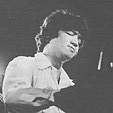S.M.B. PRESS RELEASE
about SADISTIC MIKA BAND
SADISTIC MIKA BAND
 |
 |
 |
| Kazuhiko Katoh-vocals, guitar | Mika-vocals | Masayoshi Takanaka-guitar |
|
When, three years ago, he formed a rock band, Kazuhiko Katoh ran into more than a little local opposition: the locality being Tokyo - the world's largest and most technologically advanced urban complex, simultaneously one of the most resistant to changes of attitude. The Japanese music business didn't appreciate Kazuhiko's move, not only beacause he was abandoning his position as one of the country's biggest solo stars, but also because a rock band was not considered a viable proposition in itself - it was suicidal, they said, to complete with Western rock 'n' roll on its own terms. Which was precisely what Kazuhiko intended to do: no mere duplication of Western nabds - which in Tokyo would have been a safer bet commercially - but an original style of music. He sought out four of the most accomplished musicians in the country and together they began writing and rehearsing their own material, evolving an individual brand of music. It was bona-fide rock 'n' roll; it was also distinctly Japanese. They became the Sadistic Mika Band. The name remains a mystery. Any explanation offered is likely to hide the truth; the Japanese after all are ultra-polite. (Certainly Tokyo is the world capital of S. & M., bondage and other arcane leisure activities). Anyway, Mika joined the band, as singer, odalisque and iconoclast. Beautiful, extrovert and unpredictable (by Japanese standards a total eccentric), she completed the band's line-up and clinched its distinctive identity: both musically and visually, original, sophisticated and bizarre. |
 |
 |
 |
| Hiroshi Imai-keyboards | Yukihiro Takahashi-drums | Tsugutoshi Goto-bass |
|
The first album, "The Sadistic Mika Band", was released in 1973. Uncompromising heavy rock with a pervasive Oriental underlay, it confused Japanese audiences to great effect. Virtually unnoticed in Britain, it nevertheless attained a cult reputation; Ian MacDonald in the New Musical Express declared that the album made "Iggy and the Stooges sound like the Amadeus String Quartet. And it's great - sure they're mad - but they're fighting mad". Although a single, "Cycling Boogie", had some success, the conservative trend of the market delayed any popular recognition in Japan for some time. By 1974, however, things had changed, partly due to the effect of the band's extensive touring. The Sadistic Mika Band's reputation was outstripping that of any other Japanese group, and at festivals they began to constitute a rival attraction to Western acts. About the same time Kazuhiko, in London (to buy a Rolls-Royce), met Chris Thomas, producer of Pink Floyd, Procol Harum and Roxy Music, and already an admirer of the Sadistic Mika Band. It was arranged for him to produce the band's next album in Tokyo, and the result was the stunningly impressive "Black Ship". Above all it confirmed the band's mystery in both composition and performance, and their right to recognition on a world scale. As on their first album (which the New Musical Express described as possessing the "finest album cover photo of the year"), the group's visual flair was demonstrated on "Black Ship" by the extraordinary image of the group floating - as if with wings in mid-air (an idea recently cribbed by a much more famous band). "Black Ship" shot into the Japanese charts - something which Western bands rarely achieve. |
To be continued.....
Original source of this page was taken
from
Harvest Records press release
![]()
When you have comments or further information, mail me please!